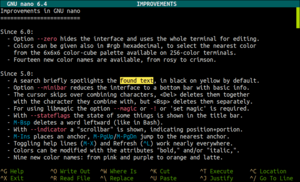GNU nanois atext editorforUnix-likecomputing systems or operating environments using acommand line interface.It emulates thePicotext editor, part of thePineemail client, and also provides additional functionality.[5]Unlike Pico, nano is licensed under theGNU General Public License(GPL). Released asfree softwareby Chris Allegretta in 1999, nano became part of theGNU Projectin 2001.[6]The logo resembles the lowercase form of theGreek letter Eta (η).
 | |
 GNU nano 6.4 | |
| Original author(s) | Chris Allegretta |
|---|---|
| Developer(s) | Benno Schulenberg |
| Initial release | 18 November 1999[1] |
| Stable release | 8.2[2] |
| Repository | |
| Written in | C |
| Operating system | Cross-platform |
| Included with | GNU based operating systems |
| Available in | English |
| Type | Text editor |
| License | 2007:GPL-3.0-or-later[a][3] 2001:GPL-2.0-or-later[b][4] 1999:GPL-1.0-or-later[c] |
| Website | nano-editor |
History
editGNUnano was first created in 1999 with the nameTIP(arecursive acronymforTIP Isn't Pico), by Chris Allegretta. His motivation was to create a free software replacement for Pico, which was not distributed under afree-software license.The name was changed to nano on January 10, 2000, to avoid a naming conflict with the existing Unix utilitytip.The name comes from the system ofSI prefixes,in whichnanois 1000 times larger thanpico.In February 2001, nano became a part of theGNU Project.
GNU nano implements several features that Pico lacks, includingsyntax highlighting,line numbers,regular expressionsearch and replace, line-by-line scrolling, multiple buffers, indenting groups of lines, rebindable key support,[7]and the undoing and redoing of edit changes.[8]
On 11 August 2003, Chris Allegretta officially handed the source code maintenance of nano to David Lawrence Ramsey.[9]On 20 December 2007, with the release of 2.0.7, Ramsey stepped down as nano's maintainer.[10]The license was also upgraded toGPL-3.0-or-later.[11]The project is currently maintained by Benno Schulenberg.[12]
On version 2.6.0 in June 2016, the current principal developer and the other active members of the nano project decided in consensus to leave the GNU Project, because of their objections over theFree Software Foundation'scopyright assignmentpolicy, and their belief that decentralized copyright ownership does not impede the ability to enforce the GNU General Public License.[13][14][15][16]The step was acknowledged byDebianandArch Linux,[17][18]while the GNU Project resisted the move and called it a "fork".[19]On 19 August 2016, Chris Allegretta announced the return of the project to the GNU family, following concessions from GNU on copyright assignment for Nano specifically,[20]which happened when version 2.7.0 was released in September 2016.[21]
Control keys
editGNU nano, like Pico, iskeyboard-oriented, controlled withcontrol keys.For example,Ctrl+Osaves the current file;Ctrl+Wgoes to the search menu. GNU nano puts a two-line "shortcut bar" at the bottom of the screen, listing many of the commands available in the current context. For a complete list,Ctrl+Ggets the help screen.
Unlike Pico, nano usesmeta keysto toggle its behavior. For example,Meta+Stoggles smooth scrolling mode on and off. Almost all features that can be selected from thecommand linecan be dynamically toggled. On keyboards without the meta key it is often mapped to the escape key,Esc,such that in order to simulate, say,Meta+Sone has to press theEsckey, then release it, and then press theSkey.
GNU nano can also use pointing devices, such as amouse,to activate functions that are on the shortcut bar, as well as position the cursor.
See also
editNotes
editReferences
edit- ^"first tarball that is still available (tip-0.5.0.tar.gz)".
- ^"[Info-nano] [ANNOUNCE] nano-8.2 is released".5 September 2024.Retrieved5 September2024.
- ^"COPYING file".11 August 2007.Retrieved2 December2020– viaGNU Savannah.
- ^"NEWS".2001-10-26.
- ^The nano FAQ:https://www.nano-editor.org/dist/v2.2/faq.html#1.3
- ^Official websiteFAQ.(accessed 17 February 2016.)
- ^Allegretta, Chris (18 March 2008)."GNU nano 2.1.0".Nano-devel mailing list.gnu.org.Retrieved18 March2008.
- ^Allegretta, Chris (23 March 2015)."GNU nano 2.4.0".Nano-devel mailing list.gnu.org.Retrieved18 April2015.
- ^Allegretta, Chris (11 August 2003)."GNU nano 1.3 branch opened in CVS".Nano-devel mailing list.gnu.org.Retrieved25 January2007.
- ^Ramsey, David Lawrence (20 December 2007)."Stepping down as the nano maintainer..."Nano-devel mailing list.gnu.org.Retrieved20 December2007.
- ^NEWSin nano.git"Finally, nano is now licensed under the GNU GPL version 3 or later, and its documentation is now dual-licensed under the GNU GPL version 3 or later and the GNU FDL version 1.2 or later."(20 December 2007)
- ^"GNU nano: Who's who".www.nano-editor.org.Retrieved2020-11-08.
- ^nano newson nano-editor.org"And, with this release, we take leave of the herd... Bye! And thanks for all the grass!"(22 June 2016)
- ^remove the GNU marker from nano's nameon savannah.org by Benno Schulenberg (13 June 2016)
- ^Re: (Nano-devel) Should nano stay a GNU program (Was: time for a 2.5.4-pon lists.gnu.org (7 May 2016)
- ^sr #109076: Request to move nano from gnu to nongnuon savannah.gnu.org by Benno Schulenberg (22 June 2016)
- ^"Accepted nano 2.6.0-1 (source amd64) into unstable".
- ^"svntogit/packages.git - Git clone of the 'packages' repository".
- ^I'm on the GNU maintainers team; I want to clarify a couple things about this: First, Nano has _not_ left the GNU Projecton news.ycombinator.com by Mike Gerwitz (June 2016)
- ^Chris, Allegretta (19 August 2016)."[Nano-devel] nano to remain in GNU".lists.gnu.org.Retrieved2 September2016.
- ^nano newson nano-editor.org"With this release we return to GNU. For just a little while we dreamt we were tigers. But we are back in the herd, back to a healthy diet of fresh green free grass."(1 September 2016)